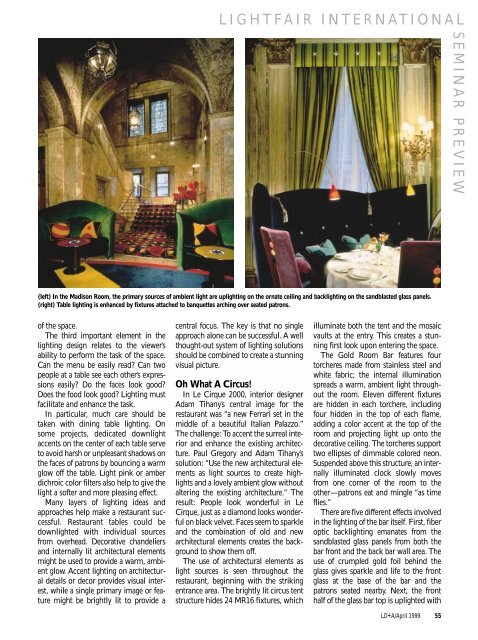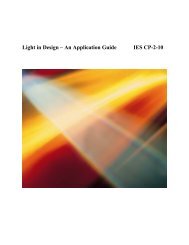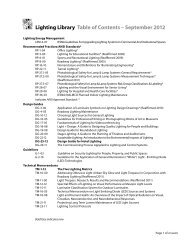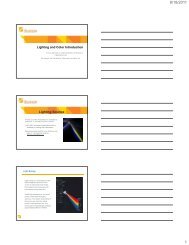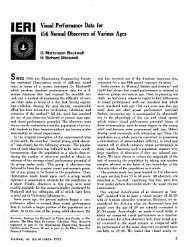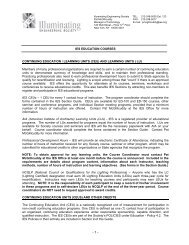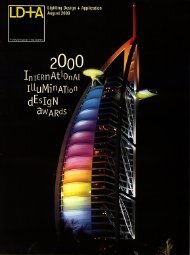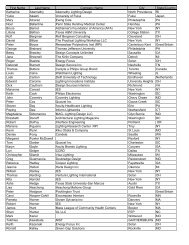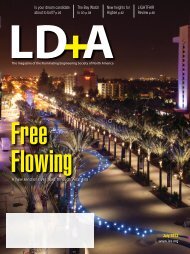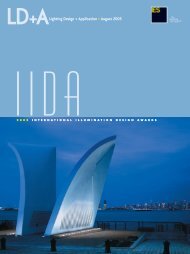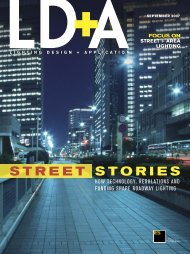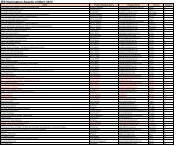lightfair international - Illuminating Engineering Society
lightfair international - Illuminating Engineering Society
lightfair international - Illuminating Engineering Society
You also want an ePaper? Increase the reach of your titles
YUMPU automatically turns print PDFs into web optimized ePapers that Google loves.
LIGHTFAIR INTERNATIONAL<br />
SEMINAR PREVIEW<br />
(left) In the Madison Room, the primary sources of ambient light are uplighting on the ornate ceiling and backlighting on the sandblasted glass panels.<br />
(right) Table lighting is enhanced by fixtures attached to banquettes arching over seated patrons.<br />
of the space.<br />
The third important element in the<br />
lighting design relates to the viewer’s<br />
ability to perform the task of the space.<br />
Can the menu be easily read Can two<br />
people at a table see each other’s expressions<br />
easily Do the faces look good<br />
Does the food look good Lighting must<br />
facilitate and enhance the task.<br />
In particular, much care should be<br />
taken with dining table lighting. On<br />
some projects, dedicated downlight<br />
accents on the center of each table serve<br />
to avoid harsh or unpleasant shadows on<br />
the faces of patrons by bouncing a warm<br />
glow off the table. Light pink or amber<br />
dichroic color filters also help to give the<br />
light a softer and more pleasing effect.<br />
Many layers of lighting ideas and<br />
approaches help make a restaurant successful.<br />
Restaurant tables could be<br />
downlighted with individual sources<br />
from overhead. Decorative chandeliers<br />
and internally lit architectural elements<br />
might be used to provide a warm, ambient<br />
glow. Accent lighting on architectural<br />
details or decor provides visual interest,<br />
while a single primary image or feature<br />
might be brightly lit to provide a<br />
central focus. The key is that no single<br />
approach alone can be successful. A well<br />
thought-out system of lighting solutions<br />
should be combined to create a stunning<br />
visual picture.<br />
Oh What A Circus!<br />
In Le Cirque 2000, interior designer<br />
Adam Tihany’s central image for the<br />
restaurant was “a new Ferrari set in the<br />
middle of a beautiful Italian Palazzo.”<br />
The challenge: To accent the surreal interior<br />
and enhance the existing architecture.<br />
Paul Gregory and Adam Tihany’s<br />
solution: “Use the new architectural elements<br />
as light sources to create highlights<br />
and a lovely ambient glow without<br />
altering the existing architecture.” The<br />
result: People look wonderful in Le<br />
Cirque, just as a diamond looks wonderful<br />
on black velvet. Faces seem to sparkle<br />
and the combination of old and new<br />
architectural elements creates the background<br />
to show them off.<br />
The use of architectural elements as<br />
light sources is seen throughout the<br />
restaurant, beginning with the striking<br />
entrance area. The brightly lit circus tent<br />
structure hides 24 MR16 fixtures, which<br />
illuminate both the tent and the mosaic<br />
vaults at the entry. This creates a stunning<br />
first look upon entering the space.<br />
The Gold Room Bar features four<br />
torcheres made from stainless steel and<br />
white fabric; the internal illumination<br />
spreads a warm, ambient light throughout<br />
the room. Eleven different fixtures<br />
are hidden in each torchere, including<br />
four hidden in the top of each flame,<br />
adding a color accent at the top of the<br />
room and projecting light up onto the<br />
decorative ceiling. The torcheres support<br />
two ellipses of dimmable colored neon.<br />
Suspended above this structure, an internally<br />
illuminated clock slowly moves<br />
from one corner of the room to the<br />
other—patrons eat and mingle “as time<br />
flies.”<br />
There are five different effects involved<br />
in the lighting of the bar itself. First, fiber<br />
optic backlighting emanates from the<br />
sandblasted glass panels from both the<br />
bar front and the back bar wall area. The<br />
use of crumpled gold foil behind the<br />
glass gives sparkle and life to the front<br />
glass at the base of the bar and the<br />
patrons seated nearby. Next, the front<br />
half of the glass bar top is uplighted with<br />
LD+A/April 1999 55


